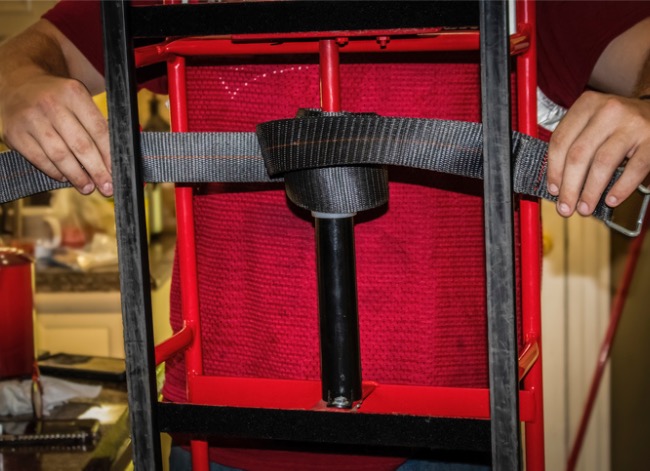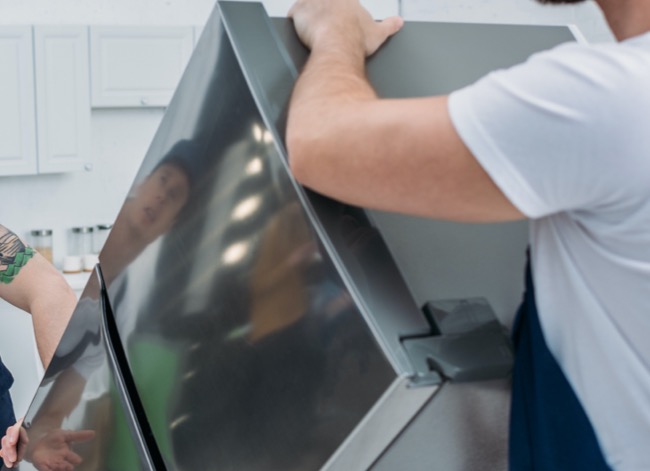We may earn revenue from the products available on this page and participate in affiliate programs. Learn More ›
When you’re starting out in a new home or renovating the kitchen in your current one, the time may come when you must figure out how to move a refrigerator. With fridges weighing anywhere between 150 and 350 pounds, doing this job incorrectly can result in bodily injuries, scratched floors, or even a broken fridge.
Whether you have a small, apartment-size refrigerator or an extra large refrigerator, you’ll need to have a partner for this task. Once you enlist a helper, rent an appliance dolly (you can rent one for about $15 a day at a hardware store), and roll up your sleeves. Follow these steps to move any kind of fridge, from side-by-side and French door fridge models to refrigerators with the freezer on the bottom. Whatever type you have, this is how to make the move easy and safe without spoiling any food, straining any muscles, or losing your cool in the process.
Tools & Materials
Bobvila.com may earn a commission from purchases made through these links.
STEP 1: Measure your fridge and your home’s doorways.
Measure and record down the width, height, and depth of your fridge. Measure and write down the width and height of the clearance of any doorways you’ll need to navigate through, remembering that the open door may protrude into the clearance space, and you have to factor that in. You may have to remove interior doors in your house, or the refrigerator’s doors. You may even have to remove house door hinges.
Carefully plan out the path you will take getting the fridge outside, and ensure you have enough clearance on all sides to safely move the appliance, the dolly, and the movers themselves. Consider the fridge’s size when it is tilted on the dolly and ensure clearance is sufficient.

STEP 2: Empty the refrigerator and stow its contents in ice chests.
You’ll find that the best way to move a refrigerator is to do as much of the preparation as you can in advance. Whether you’re moving the appliance across the room or the country, when you’re moving a fridge from point A to point B, the last thing you’ll want is for those soda cans and pickle jars to rattle around and break open along the way. Equally important, you’ll want to avoid the spoilage that will almost certainly occur if you leave food in an unplugged fridge. Before moving a refrigerator, store perishables in an ice chest or two, along with with ice or frozen bottles of water to keep their contents cool. Next, remove any ice cube trays, movable shelves, and other accessories that might shift “mid-flight,” and don’t forget to remove magnets and other decorative elements from the exterior.
STEP 3: Unplug the refrigerator.
Unplug the refrigerator from the wall. If you have a built-in icemaker, disconnect the fridge from its water source as well. Gather the cords up in a coil and secure them tightly with a zip tie or a few loops of painter’s tape (masking tape is also an option but may leave adhesive residue). Allow 6 to 8 hours for the interior to defrost completely; if you skip this step, you’ll run the risk of the fridge’s interior growing mold or even leaking all over the moving truck while in transit.
Pro tip: Unplug the appliance the night before you move it so everything’s ready to roll in the morning. Once the interior reaches room temperature, use a towel to wipe away any melted frost from the freezer drawer.
STEP 4: Secure the refrigerator doors.
Wrap two or more bungee cords around the appliance like moving straps—one around the upper half and one around the lower half—to keep the doors closed when you move the refrigerator. If you don’t have bungee cords, two long rolls of plastic wrap secured tightly around the fridge can do the trick almost as well; be sure to get a snug fit and tape off the ends to reinforce. If possible, tie the door handles together as well to make sure everything stays firmly in place during transport.
STEP 5: Strategically position the dolly.
Roll up the dolly and gently center the tow blade under the bottom of the fridge, approaching it from the side with the fridge doors at a 90-degree angle from the back of the dolly. Note that you should never lay a fridge on its side or back to move it because tipping it too far in the wrong direction can cause a coolant breach, reducing your fridge to little more than a big, broken metal box. Using an appliance dolly correctly, you’ll be able to tilt the fridge slightly sideways to move it without leaning it too far over.
For this two-person job, one person will position the dolly underneath the fridge and stay behind it with hands on handles, keeping it in place. The tow blade should just slide right underneath the appliance without having to be forced. Now, the helper uses the dolly’s straps to lock it down by encircling the refrigerator’s body like a belt, similar to the way you secured the doors closed with bungees or plastic wrap. If the dolly has a ratchet mechanism (found on its back), use that to pull the strap tight and keep the fridge securely fastened to the dolly itself while it’s moving. If there’s no ratchet, tie a tight double knot, anchoring it to the steel ribs between the dolly’s handles.

STEP 6: Tilt and move the refrigerator.
Position yourselves so that one person is standing behind the dolly, holding it by both handles to guide the movement, and the other is standing in front of the doors, able to react quickly in case anything hasn’t been secured correctly and the fridge starts to slide or the doors begin to open.
Together, slightly tilt the fridge and dolly back between 20 and 45 degrees—just enough for the wheels to move freely when the person holding the dolly’s handles gives it a gentle push or pull, depending on whether you need to move forward or backward. When you and the fridge are steady, slowly begin work your way to the moving truck (or simply out of the way, in the case of a renovation). Be sure to keep the appliance tilted no more than 45 degrees for the entire journey and take caution as needed while navigating around corners, through doorways and up or down ramps of any kind.
Don’t Forget! When moving a refrigerator, it’s critical to never lay or carry your appliance on its back or side. Doing so can create an irreparable leak in the cooling system and prevent the appliance from doing its job when you plug it back in. You should also avoid moving refrigerators while they’re still cooling down and filled with condensation, conditions that make the interior a breeding ground for mold and bacteria. Prepare carefully, take your time, and be sure to use a large enough dolly to get the job done safely. After following these easy steps for how to move a fridge, you’ll be chilling in your new kitchen in no time flat.

Final Thoughts
There are perhaps more steps to moving a fridge than you considered but the process isn’t a particularly complicated one, and there’s no reason to leave it behind. Empty, clean out, and unplug the refrigerator. Measure the appliance and doorways and plan your move carefully.
Recruit a helper to secure the fridge, load it on the dolly, and move carefully and efficiently it to the van, across the room, or maybe out to the garage if you’re getting a new fridge for the kitchen.
FAQs About the Easiest Way to Move a Fridge
Ready to hop in the moving van to begin your new adventure? Wait! Check out these final frequently asked questions about moving a fridge to ensure you have every bit of relevant information.
Q: Can you move a fridge straight after turning it off?
You can, but you run the risk of damaging the inner workings. Your fridge may leak all over the moving truck or your hardwood floors, if you’ve temporarily moved it to the living room during renovation. Mold and bacteria can grow inside the fridge, too, if it is turned off and moved without being dried out.
Q: Can a refrigerator be transported on its side?
Don’t transport a refrigerator on its side. This can cause a coolant breach, essentially ruining the appliance.
Q: Can you transport a refrigerator laying down?
Nope. Again, transporting a refrigerator on its back or side risks a coolant leak.
Q: How long after unplugging a fridge can you move it?
Best practice is to unplug and clean out your fridge the night before a move. Then, to make sure it is completely dry, give the appliance a thorough wipedown in the morning before it is moved.
Q: Do modern fridges need to settle before turning on again?
Common wisdom holds that it is a good idea to allow a recently moved refrigerator to sit upright for 2-4 hours before plugging it in to allow the compressor oil to settle back in where it belongs. If you know the unit was transported on its side, wait 24 hours and then hope for the best.


